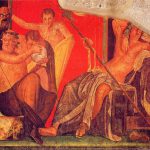Bas-relief shows the profile of a figure with long hair, wearing a diadem decorated with leaves and bunches of grapes. The head rests on a wicker basket, partially covered with goatskin.
Initially, the relief was described as Bacchus, but the most likely interpretation would be the face of a manada or bacchant, a woman devoted to the cult of the deity of Dionysus, as evidenced by numerous Dionysian symbols, and namely, goatskin, vine shoots, basket and tiara. The choice of red marble and the resemblance of the relief to theatrical masks are further allusions to Dionysus, the god of wine and theatre. The presence of two openings at the place of the eye and the mouth suggests that the plate was used to pass water and belonged to the decoration of the fountain in the large bath complex. The stylistic characteristics of the relief and the use of “rosso antico” marble, originating from Greece, allows to place the work in the reign of Emperor Hadrian, in the first half of the 2nd century CE.
The object is located in the Museo di Roma- Palazzo Braschi.







